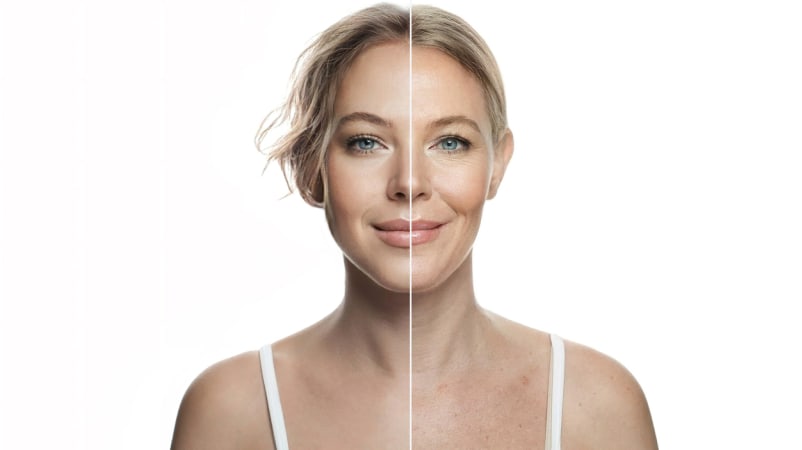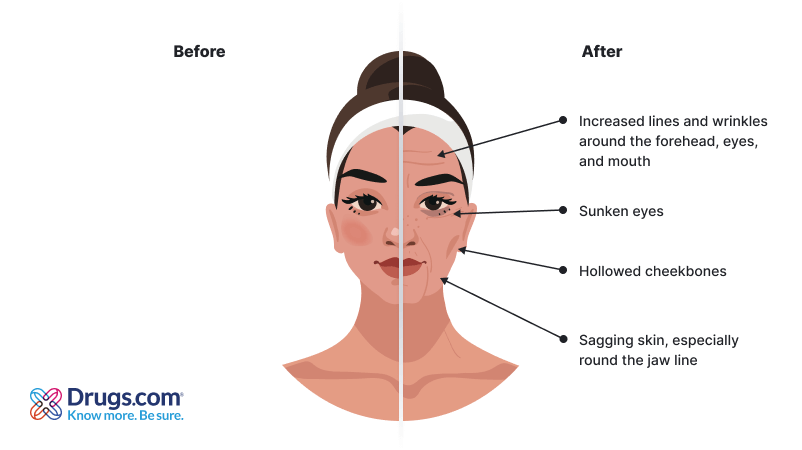Ozempic Face: What causes it and how to prevent it?
Ozempic Face refers to the noticeable facial changes seen after significant and fast weight loss, which often happens with Ozempic and other GLP-1 medications, such as Mounjaro, Zepbound, or Wegovy. Ozempic Face is a term that describes gaunt and hallowed cheekbones, increased lines and wrinkles around the face, sunken eyes, dark circles around the eyes, and sagging skin around the jaw bone and neck.
Overall, this causes people to look older than they actually are, and the problem is compounded by how GLP-1 drugs affect body composition during weight loss. Research shows that lean muscle mass accounts for 25% to 40% of the weight a person loses when using GLP-1 drugs like Ozempic, which can contribute to the gaunt, aged appearance some users experience. This significant muscle loss, in addition to loss of facial fat, can accentuate facial hollowing and sagging skin that characterizes "Ozempic Face." However, it is possible that the features described by Ozempic Face could happen with any major dietary shift, drastic weight loss with gastric bypass surgery, or starvation.
Most people who take Ozempic will not develop the pronounced features of Ozempic Face, but their face may appear slimmer as they lose weight.
What does Ozempic Face look like?
Weight loss in the face can result in several noticeable changes, including:
- Sunken eyes or dark circles under the eyes
- Hollowed cheekbones or temples
- Increased wrinkles around the eyes, forehead, and mouth
- Sagging skin around the jawline and jowls.
These changes can create a gaunt or aged appearance.
These changes may be more noticeable in people with a longer face because of the way the skin is stretched and the position of the underlying muscles.
Women and older adults with obesity may also lose more muscle mass than other groups. Higher protein intake may help mitigate this risk.
What causes Ozempic Face?
Ozempic Face is primarily caused by rapid weight loss, and the changes GLP-1 drugs make to our body composition of fat, muscle, and water. The contributing factors include:
- Facial fat loss: Weight loss affects fat throughout the body, including the face, leading to a loss of volume and support under the skin. Fat in our face helps to give us a more youthful look
- Facial muscle loss: Each side of our face contains around 30 muscles that control our facial expressions and enable us to chew and swallow and perform other functions, such as blinking and yawning. 25 to 40% of the weight a person loses with GLP-1 drugs such as Ozempic is lean muscle mass, which affects the face as well as the whole body
- Reduced skin elasticity: Aging reduces the skin's ability to bounce back after fat loss, causing sagging and wrinkles. The older you are, the more likely that your skin will not bounce back the same
- Rapid fat and muscle loss: Losing weight quickly gives the skin less time to adjust, exacerbating loose and sagging skin.
Ozempic (semaglutide), aids weight loss by mimicking the hormone GLP-1, which reduces appetite and increases feelings of fullness. While this leads to effective weight loss, the associated facial changes result from fat reduction and loss of muscle mass.
Ozempic Face Before and After

Celebrities with Ozempic Face
Ozempic and other GLP-1 drugs have surged in popularity among Hollywood celebrities and other prominent people who have wanted to lose weight easily. Celebrities who appear to have features of Ozempic Face include:
- Katy Perry
- Robbie Williams
- Lizzo
- Scott Disick
- Sharon Osbourne
- John Goodman
- Christina Aguilera
- Boy George.
How can you prevent Ozempic Face?
Although you cannot completely prevent Ozempic Face, there are strategies to minimize its effects:
- Try to lose weight slowly
- Work with your healthcare provider to lose weight at a slower pace by adjusting your medication dosage if necessary.
- Increase your dietary protein intake
- Aim for 20 to 30 grams of protein at each meal, or 1 to 1.5 grams of protein per kilogram of body weight daily. Good sources of protein include lean meats such as fish, beef, or poultry; eggs; nuts and seeds; tofu; and legumes such as beans and lentils.
- If you have a poor appetite, drink protein shakes with at least 20 grams of protein per serving.
- Integrate strength training into your exercise regimen
- Aim for 2 to 3 strength training sessions a week, in addition to daily exercise.
- Eat a well-balanced, nutrient-dense diet
- Avoid diets that restrict calories, which can miss out essential nutrients and vitamins and cause malnutrition or unhealthy weight loss
- Stay hydrated
- Drink 4 to 8 glasses (1 to 2 liters) of water a day.
- Flavor your water.
- Eat water-rich fruits and vegetables such as watermelon, strawberries, cucumbers, zucchini, or tomatoes.
- Avoid alcohol.
- Eat smaller meals plus snacks
- GLP-1 drugs can reduce your appetite which may affect your energy levels.
- Eat smaller meals plus healthy snacks such as fruit, nuts, or unsweetened yogurt.
- Choose slowly digested carbohydrates such as oatmeal or sweet potatoes instead of sugary drinks or highly processed grains such as white bread which can cause blood sugar swings.
- Use skincare products
- Apply moisturizers, hyaluronic acid, and collagen-boosting products to improve skin elasticity and reduce wrinkles.
- Consider medical treatments
- If the changes become bothersome, talk to a healthcare provider about non-invasive or minimally invasive skin treatments.
- Facial fillers restore lost volume in areas like the cheeks and under the eye.
- Skin-tightening treatments such as radiofrequency or laser therapy improve elasticity.
Related questions
- Mounjaro vs Ozempic: Which is right for you?
- Ozempic Side Effects to Watch For
- What are the long-term side effects of Ozempic?
FAQs about Ozempic Face
Can Ozempic Face be reversed?
Yes, some effects may improve if weight is regained, or when the skin adjusts in younger people. Minimally invasive treatments such as facial fillers can help restore volume, smooth wrinkles and lines, and enhance facial features. Botox and other cosmetic injectables can also help improve the appearance of wrinkles.
Because dehydration can increase the appearance of wrinkles and lines in the face, staying well-hydrated by drinking 1 to 2 liters of water each day will hydrate and plump the skin and help minimize the appearance of Ozempic Face. Hydration also supports the skin's natural repair process.
A consistent skincare routine can help keep your skin barrier healthy. Use good quality products that contain ingredients such as hyaluronic acid to hydrate and plump the skin and niacinamide and peptides to slow signs of aging.
In severe cases, reconstructive surgery may be required.
Do other medications cause Ozempic Face?
Yes, similar effects can occur with other weight loss medications like Wegovy, Zepbound, and Mounjaro.
Should I stop taking Ozempic if I notice facial changes?
Do not stop taking Ozempic without consulting your healthcare provider. Discuss strategies to manage weight loss and facial changes.
Key takeaways
Speak with your healthcare provider if you're concerned about Ozempic Face or other weight loss effects. They can help you find a balance that supports your overall health and appearance.
- Ozempic Face is a result of rapid weight loss, and may be related to how GLP-1 drugs, such as Ozempic, affect body composition, in particular, how they reduce muscle mass and affect facial fat.
- Gradual weight loss, boosting protein intake, proper hydration, and strength-training can reduce its effects.
- Skincare and medical treatments like fillers or skin-tightening procedures can improve facial appearance.
References
- Ozempic. Drugs.com https://www.drugs.com/ozempic.html
- Wesley N. Facial lipoatrophy with semaglutide-related weight loss. Cutis. February 10, 2023. https://www.mdedge.com/dermatology/article/261159/aesthetic-dermatology/facial-lipoatrophy-semaglutide-related-weight-loss
- Semaglutide for weight loss - what you need to know. UCLA Health. Jan 12, 2023. https://www.uclahealth.org/news/semaglutide-weight-loss-what-you-need-know
- Ozempic Prescribing Information. https://www.novo-pi.com/ozempic.pdf
- Experts Recommend Healthy Lifestyle Changes Alongside GLP-1 Drug Use. https://www.drugs.com/news/experts-recommend-healthy-lifestyle-changes-alongside-glp-1-125820.html
- Consuming more protein may protect patients taking anti-obesity drug from muscle loss. July 12, 2025. Endocrine Society. https://www.endocrine.org/news-and-advocacy/news-room/endo-annual-meeting/endo-2025-press-releases/haines-press-release
Read next
Ozempic Mounjaro Wegovy & Zepbound: Weight Loss Compared
Ozempic, Mounjaro, Wegovy and Zepbound can all lead to long-term weight loss, but only Wegovy and Zepbound are approved by the FDA for this use. In studies, Zepbound has led to a 21% weight loss in adults using the highest dose, while Wegovy has led to about a 15% weight loss.
Continue reading
Wegovy vs Ozempic: Which is Right for You?
Both Wegovy and Ozempic contain semaglutide, but Wegovy is prescribed for long-term weight management while Ozempic is used to control blood sugar levels in type 2 diabetes and help protect kidney function. They both lower the risk for heart-related complications, but they differ in other approved uses, doses, target populations and costs.
Continue reading
How long does it take for Ozempic to work?
Your blood glucose (sugar) levels should start to fully decline within the first week after you start using Ozempic (semaglutide) at your regular dose. However, the full effect can take 8 weeks or longer, as this is a long-acting medication that is injected only once per week. Continue reading
See also:
Related medical questions
- How many doses are in an Ozempic pen?
- Do Ozempic, Wegovy, Mounjaro & Zepbound cause hair loss?
- How does Ozempic work for weight loss?
- Which GLP-1 drug is best for weight loss?
- Can you switch between Ozempic and Mounjaro?
- Does Ozempic need to be refrigerated?
- What happens when you stop taking Ozempic?
- Will my insurance cover the cost of Ozempic?
- Saxenda vs Ozempic: For Weight Loss?
- Can you get tirzepatide from a compounding pharmacy?
- When is the best time of day to take Ozempic?
- Why am I not losing weight on Ozempic?
- Does Ozempic cause muscle loss and how to prevent it?
- Can you buy Ozempic over the counter?
- Are there natural alternatives to Ozempic for weight loss?
- Do GLP-1 drugs like Ozempic and Mounjaro cause sulfur burps?
- Where and how should Ozempic be injected?
- Rybelsus vs Ozempic for weight loss: Which to choose?
- How long does Ozempic last in your system?
- How long can you stay on Ozempic?
- How does Ozempic affect blood pressure?
- Ozempic and Surgery: When to stop and restart?
- How do Ozempic and Metformin compare for diabetes?
- 6 Wegovy side effects you need to be aware of
- How long until I'll lose weight with Wegovy?
- How do Zepbound and Wegovy compare?
- How do you get Wegovy covered by insurance?
- When is the best time of day to take Wegovy?
- Wegovy vs Mounjaro: Which works best for weight loss?
- Why am I not losing weight on Wegovy?
Drug information
Related support groups
- Ozempic (115 questions, 228 members)
- Wegovy (50 questions, 115 members)
- Semaglutide (38 questions, 53 members)
- Weight Loss (Obesity/Overweight) (875 questions, 1,514 members)
- Diabetes, Type 2 (513 questions, 1,430 members)
- Cardiovascular Risk Reduction (102 questions, 28 members)
- Facial Wrinkles (18 questions, 36 members)
- Facial Lipoatrophy (2 questions, 4 members)

